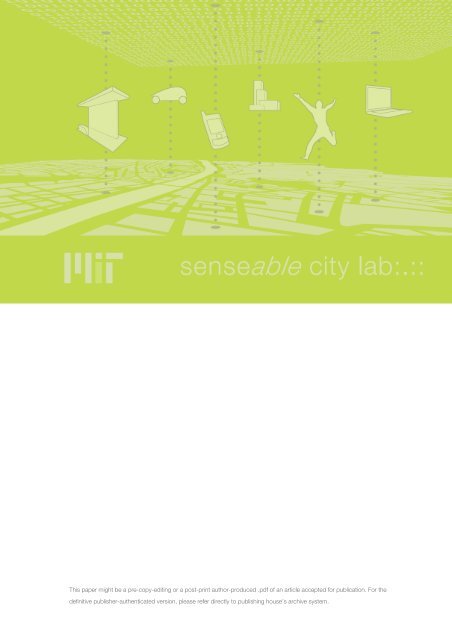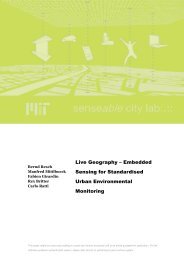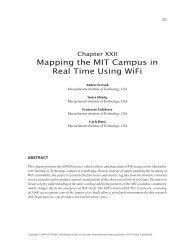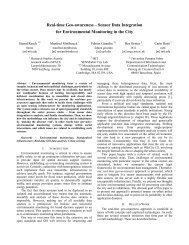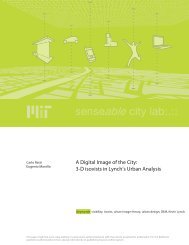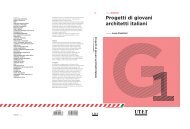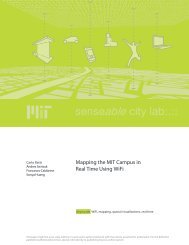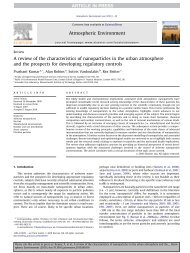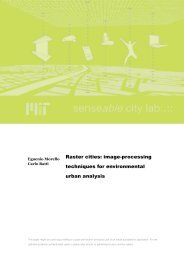author's proof
author's proof
author's proof
Create successful ePaper yourself
Turn your PDF publications into a flip-book with our unique Google optimized e-Paper software.
This paper might be a pre-copy-editing or a post-print author-produced .pdf of an article accepted for publication. For thedefinitive publisher-authenticated version, please refer directly to publishing house’s archive system.
AUTHOR'S PROOF132Environ Model AssessDOI 10.1007/s10666-010-9236-0JrnlID 10666_ArtID 9236_Proof# 1 - 21/08/20104 Numerical Model Inter-comparison for Wind Flow5 and Turbulence Around Single-Block Buildings6 Sotiris Vardoulakis & Reneta Dimitrova & Kate Richards & David Hamlyn &7 Giorgio Camilleri & Mark Weeks & Jean-François Sini & Rex Britter & Carlos Borrego &8 Michael Schatzmann & Nicolas Moussiopoulos9 Received: 19 August 2009 /Accepted: 16 August 201010 # Springer Science+Business Media B.V. 20101112 Abstract Wind flow and turbulence within the urban13 canopy layer can influence the heating and ventilation of14 buildings, affecting the health and comfort of pedestrians,15 commuters and building occupants. In addition, the predic-16 tive capability of pollutant dispersion models is heavily17 dependent on wind flow models. For that reason, well-18 validated microscale models are needed for the simulation of19 wind fields within built-up urban microenvironments. To20 address this need, an inter-comparison study of several such21 models was carried out within the European research22 network ATREUS. This work was conducted as part of an23 evaluation study for microscale numerical models, so theyS. Vardoulakis : M. Weeks : C. BorregoDepartment of Environment and Planning, University of Aveiro,3810-193 Aveiro, PortugalR. Dimitrova : J.-F. SiniLaboratoire de Mécanique des Fluides, Ecole Centrale de Nantes,BP 92101, 44321 Nantes Cedex 3, FranceK. Richards : M. SchatzmannMeteorological Institute, University of Hamburg,Bundesstrasse 55,20146 Hamburg, Germanycould be further implemented to provide reliable wind fieldsfor building energy simulation and pollutant dispersioncodes. Four computational fluid dynamics (CFD) models(CHENSI, MIMO, VADIS and FLUENT) were applied toreduced-scale single-block buildings, for which qualityassuredand fully documented experimental data wereobtained. Simulated wind and turbulence fields around twosurface-mounted cubes of different dimensions and wallroughness were compared against experimental data producedin the wind tunnels of the Meteorological Institute ofHamburg University under different inflow and boundaryconditions. The models reproduced reasonably well thegeneral flow patterns around the single-block buildings,although over-predictions of the turbulent kinetic energywere observed near stagnation points in the upwindimpingement region. Certain discrepancies between theCFD models were also identified and interpreted. Finally,some general recommendations for CFD model evaluationand use in environmental applications are presented.UNCORRECTED PROOFKeywords CFD . Wind flow. Turbulent kinetic energy.Building microclimate . Pollutant dispersion . Modelevaluation24252627282930313233343536373839404142434445D. Hamlyn : R. BritterDepartment of Engineering, University of Cambridge,Cambridge CB2 1PZ, UKG. Camilleri : N. MoussiopoulosLaboratory of Heat Transfer and Environmental Engineering,Aristotle University of Thessaloniki,54124 Thessaloniki, GreeceS. Vardoulakis (*)Centre for Radiation, Chemical and Environmental Hazards,Health Protection Agency,Chilton, Didcot,Oxon OX11 0RQ, UKe-mail: sotiris.vardoulakis@hpa.org.uk1 IntroductionMicroclimatic conditions have been recognised as amajor influence on the energy behaviour of buildings,especially in urban environments where wind circulationand shading effects can vary widely [1]. These conditionsmay be affected by changes in the urban canopy layout,vegetation, building materials, heating and ventilation,road traffic patterns and larger-scale climatic changes. Forexample, the installation of large numbers of air conditioningunits in offices and residential buildings can46474849505152535455
AUTHOR'S PROOFJrnlID 10666_ArtID 9236_Proof# 1 - 21/08/2010S. Vardoulakis et al.56 increase heat emissions within street canyons, exacerbat-57 ing the urban heat island effect [2]. Microclimatic58 condition also affects pollutant dispersion within the59 urban environment and entrainment into buildings [3].60 Numerical computational fluid dynamic (CFD) models61 can help simulate different microclimatic scenarios and62 establish their impact on the energy behaviour of buildings,63 as well as on pollutant dispersion and entrainment.64 Individual CFD models have been commonly used to study65 wind, temperature and air pollution fields in outdoor urban66 environments [4–7], industrial sites [8], public transport67 facilities [9], indoor building environments [9–12] and68 around the human body [13]. In these applications, the69 Reynolds Averaged Navier–Stokes (RANS) modelling70 approach has been widely used [14, 15], although more71 advanced modelling methods such as Large Eddy Simu-72 lations (LES) are becoming increasingly popular [16, 17].73 Several attempts have been made to simulate surface-74 mounted cubes, either as isolated structures or a periodic75 array, using CFD models [18–20]. Despite their simplicity,76 isolated surface-mounted cubes within a well-developed77 wind flow can reproduce the most salient features of wind78 flow around real buildings, i.e. sharp pressure gradients,79 multiple separation and re-attachment regions, as shown by80 wind tunnel flow visualisation experiments [21]. For this81 reason, they have been commonly used as a benchmark for82 the evaluation of CFD models [22]. More complex83 geometries of buildings with varying aspect ratios (i.e.84 height-to-width) or roof shapes, as well as arrays of85 different-sized and different-shaped buildings, have also86 been used for model evaluation [23, 24].87 It has been demonstrated that similar numerical models,88 based on the same physical principles and mathematical89 formulation and using the same input and boundary conditions,90 can give significantly different results [24, 25]. This is often91 due to differences in coding, parameterisation, grid resolution92 and input data pre-processing but also due to different levels93 of the user’s expertise. For that reason, it is essential that94 commercially available as well as research-oriented numerical95 models are comprehensively evaluated using quality-assured96 and fully documented experimental datasets.97 Microscale numerical models have often been validated98 against experimental reduced-scale wind tunnel data [26] or99 less commonly against full-scale field data [27, 28]. The100 two most common reduced-scale modelling techniques are101 wind tunnel and water tank modelling, both based on the102 similarity principle (i.e. original full-scale flow conditions103 reproduced by reducing the geometrical scale of structures104 and adjusting reference parameters such as wind velocity).105 Wind tunnel experiments have been more commonly used106 to simulate atmospheric flows [29], although water tank107 experiments have also been used in the past [18]. In108 addition to reduced-scale setups, full-scale experimentsaround real buildings have been used for numerical modelvalidation [30]. Although good agreement is generallyexpected between reduced- and full-scale modelling results,certain discrepancies in the wind flow field near the roofand leeward side of buildings may be observed, dependingon approach flow conditions and scale [31, 32].The present study explores the capability of four CFDcodes to reproduce experimental wind flows around isolatedsingle-block buildings, using the commonly used steadystateRANS approach. Two isolated cubes, representing thesimplest structural unit of urban canopies, mounted in windtunnels were used to test the selected models and developcertain recommendations for numerical model use and intercomparison.This study has been carried out within theEuropean research network Advanced Tools for RationalEnergy Use towards Sustainability (ATREUS with emphasison microclimatic issues in urban applications), as part of anevaluation study for these models so they could be furtherimplemented to provide boundary condition data for buildingsimulation codes. Put into context, the overall objective ofATREUS was to study the wind–building interactions, takinginto account local meteorological and microclimatic conditionsthrough the synthesis of climate models on all scales, i.e.from mesoscale to microscale to the building environment[33].2 Methodology2.1 Experimental DatasetsIn the present study, two quality-assured and fully documentedexperimental datasets produced in the wind tunnelsof the Meteorological Institute of Hamburg University,Germany, were used for the evaluation of the numericalmodels. The experimental datasets included wind andturbulence fields around two surface-mounted cubes ofdifferent dimensions and wall roughness:UNCORRECTED PROOF(a) The CEDVAL cube (0.125 m×0.125 m×0.125 m)which was studied in the BLASIUS wind tunnel. Thisis a conventional-type boundary layer wind tunnelwith a 15-m-long and 1-m-high test section and a 4-mwideturn table [23](b) The ATREUS cube (0.190 m×0.190 m×0.190 m)which was built for the purpose of this study andplaced in a multi-layer stratified wind tunnel. Thistunnel is of closed circuit type with its returnsection made up of nine horizontal ducts ofrectangular shape. The height and width of theircross sections are 0.12 and 2.3 m, respectively. Theusable length of the test section of the wind tunnelis about 4.5 m [34, 35]. More information about the109110111112113114115116117118119120121122123124125126127128129130131132133134135136137138139140141142143144145146147148149150151152153154155156
AUTHOR'S PROOFNumerical Model Inter-comparison for Wind Flow and TurbulenceJrnlID 10666_ArtID 9236_Proof# 1 - 21/08/2010Q1157 two wind tunnels is available at http://www.mi.uni-158 hamburg.de/Facilities.311.0.html [36].159160 The velocity measurements were carried out using a 2-D161 Laser Doppler anemometer with 0.05-m/s accuracy in both162 cases. The neutral atmospheric boundary layer and single-163 block buildings were modelled at a scale of 1:200 and164 1:100 for CEDVAL and ATREUS, respectively. Arrange-165 ments of sharp-edged roughness elements and upstream166 vortex generators were used to simulate the atmospheric167 boundary layer approach flow over an urban area. The168 blockage ratio of the wind tunnel models, i.e. the ratio of169 the cube frontal area to the test section area, was less than170 1.5%, and the incident-wind direction was perpendicular to171 one of the cube walls in both cases.172 2.2 Numerical Models173 Four three-dimensional CFD codes were applied to the two174 surface-mounted cube test cases: (1) CHENSI, a research175 code which has been used to simulate wind flow and traffic176 pollutant dispersion at local scales [26]; (2) MIMO, a177 research code which allows describing the air motion near178 complex obstacles such as building structures [37–39]; (3)179 VADIS, also a research code which has been used in a180 range of microscale atmospheric flow and pollutant181 dispersion studies [40]; and (4) FLUENT a general-182 purpose CFD model that has been used in a wide range of183 environmental flow studies [41–43]. A detailed description184 of the models used in this study can be found in the Model185 Documentation System of the European Topic Centre on186 Air and Climate Change [44].187 In the present study, all models utilised the steady-state188 RANS equations for momentum conservation and conti-189 nuity applying the Boussinesq eddy viscosity approxima-190 tion, with the standard k-ε turbulence closure model [45]191 for calculating wind and turbulence fields around the192 cubes. The governing equations, described in detail193 elsewhere [26], were solved numerically on a staggered194 grid (ARAKAWA C type) using a finite difference195 discretisation procedure. Scalar quantities such as the196 pressure were defined at the centre of grid cells, while197 velocity components were specified at the centre of the198 appropriate interface between two cells. For the numerical199 treatment of advective transport, a three-dimensional200 second-order total variation diminishing scheme is imple-201 mented in MIMO, while diffusion terms are treated by a202 second-order central difference scheme. Similarly,203 CHENSI uses central differences for the diffusion and204 source terms and an upwind-weighted scheme for the205 advection terms [26]. In FLUENT, the coupled velocity–206 pressure equations are solved with the Semi-ImplicitMethod for Pressure-Linked Equations (SIMPLE) algorithm[46], resulting in a set of algebraic equations whichare solved using a line-by-line tri-diagonal matrix algorithm(TDMA). Second-order discretisation schemes areused both for the convection and the viscous terms of thegoverning equations. VADIS also uses the SIMPLEalgorithm and TDMA to solve the discretised fluid flowequations [40].2.3 Computational Domains and Boundary ConditionsThe four CFD models were set up with the samecomputational domain dimensions and grid size, usingGAMBIT geometry and mesh generator for FLUENT[47] or embedded model-specific mesh generators for theother three codes. After carrying out grid-independencetests involving several meshes for each model, nonequidistantCartesian grids refined near the cube wereimplemented in order to achieve high resolution in theregions of interest (i.e. flow impingement, separation andre-circulation). The final full computational domainsconsisted of a 1.10×0.75×0.69-m area discretised as a176×120×110 grid for the CEDVAL cube and a 2.09×1.71×0.95-m area discretised as a 220×180×100 grid forthe ATREUS cube. Vertical profiles of the horizontal windcomponent and turbulent kinetic energy fitted to theexperimental wind tunnel data were used at the inflowboundary. The turbulent kinetic energy k was calculatedfrom the fluctuation of the measured 2-D velocitycomponents u and w (in metres per second) using thefollowing relationship:k ¼ 1 pffiffiffiffiffiffi 2 pffiffiffiffiffiffiffi 2u20 2 þ 2 w 0 2ð1ÞThe turbulent kinetic energy dissipation ε (in squaremetres per cubic second) at the inflow boundary wascalculated from the expression:UNCORRECTED PROOF" ¼ C 3=4mk 3=2k zð2Þwhere z is the height above the floor (in metres), κ thedimensionless von Kármán’s constant (κ=0.40), C μ adimensionless numerical constant (C μ =0.09) and k theTable 1 Aerodynamic wall roughness (Z o ), friction velocity ðu»Þ,reference velocity (U ref ) at height Z ref (4H upstream) for the twosurface-mounted cubesZo (m)u» ðm=sÞ Uref (m/s) Zref (m)CEDVAL 0.0004 0.3500 5 0.685ATREUS 0.0365 0.0755 1 0.740207208209210211212213214215216217218219220221222223224225226227228229230231232233234235236 237238239240 241242243t1.1t1.2t1.3t1.4
AUTHOR'S PROOFJrnlID 10666_ArtID 9236_Proof# 1 - 21/08/2010S. Vardoulakis et al.Fig. 1 Measuring positions inthe central plane of the twosurface-mounted cubes.CEDVAL cube: H=0.125 m;modelling domain x 8.8H, y 6H,z 5.5H. ATREUS cube: H=0.190 m; modelling domain x11H, y 9H, z 5HINFLOWwindX/H = – 1.5X/H = – 0.625DIRICHLET & NEUMANNCONDITIONSHX/H = 0HX/H = + 0.625X/H = + 1.5X/H = + 2.5OUTFLOW244 mean turbulent kinetic energy (in square metres per square245 second). The values of aerodynamic wall roughness and246 friction velocity obtained from the two wind tunnel247 experiments, CEDVAL and ATREUS, were used in the248 CFD model simulations. A summary of model boundary249 and inflow conditions is presented in Table 1.250 Standard log-law wall functions were used in all models251 for near-wall treatment [48]. Furthermore, Dirichlet con-252 ditions were imposed at the top boundary of the domain for253 all field variables, except for pressure (Neumann condi-254 tion). Symmetry and Neumann conditions were imposed at255 the lateral faces of the domain in order to reproduce the256 wind tunnel conditions.257 2.4 Model Evaluation258 Detailed comparisons between observed and predicted259 vertical profiles of the longitudinal component of wind260 velocity (u), the vertical component of wind velocity (w)and the turbulent kinetic energy (k) in the centre plane offlow were performed at positions x/H=−1.5, x/H=−0.625,x/H=0, x/H=0.625, x/H=1.5 and x/H=2.5, where x is thehorizontal distance from the centre of the cube and H theheight of the cube (both in metres) as indicated in Fig. 1.Characteristic lengths of the simulated wind flows, i.e.stagnation, separation and re-attachment points as indicatedin Fig. 2, were compared against wind tunnel data inTable 2.In addition, the hit rate Q, which specifies the percentageof the model results within an allowed range of values, hasbeen used to evaluate the performance of the models. Thehit rate has been calculated as follows:Qð%Þ ¼ 100 N i withni¼1( ð3ÞN i ¼ 1for P i O iO i D2 elseUNCORRECTED PROOFZXYX nH261262263264265266267268269270271272273Fig. 2 Characteristic lengths ofperpendicular wind flow aroundATREUS cube as simulated byCHENSIX F /H
AUTHOR'S PROOFNumerical Model Inter-comparison for Wind Flow and Turbulencet2.1 Table 2 Characteristic lengthsof the flow field for theCEDVAL and ATREUS cubesJrnlID 10666_ArtID 9236_Proof# 1 - 21/08/2010Model Stagnation (Z S /H) Separation (X F /H) Re-attachment (X R /H)CEDVAL ATREUS CEDVAL ATREUS CEDVAL ATREUSWind tunnel 0.64 0.70 −0.88 −0.75 1.50 1.34CHENSI 0.62 0.80 −0.74 −0.77 2.18 1.89VADIS 0.72 0.80 −0.83 −0.53 1.33 1.23MIMO 0.68 0.79 −0.73 −0.50 2.27 2.19FLUENT 0.65 0.88 −0.72 −0.55 2.24 1.60t2.2t2.3t2.4t2.5t2.6t2.7t2.8Q1274 275 where P i are the model results and O i the wind tunnel276 results for u, v and k (u and v were normalised with the free277 stream velocity U ref , and k was normalised with Uref 2 ), n is278 the number of observations, and D is the allowed deviation279 from the observed data. In this study, the hit rate has been280 calculated separately for each model at (1) all six positions281 in the centre plane of flow as specified above (full282 modelling domain) and at (2) the three positions around283 the single-block building: x/H=−0.625, x/H=0 and x/H=284 0.625 (building domain). The performance of the models was285 separately assessed for these two domains, i.e. full modelling286 and building domains, because of the varying capability of287 CFD models to capture wind flow characteristics near the288 building walls. In this area (i.e. building domain), the accuracy289 of the results is more important for building energy290 simulations. Furthermore, D has been specified as 10% or291 20% of the observed longitudinal wind velocity (u), vertical292 wind velocity (w) and turbulent kinetic energy (k). Model293 performance was also tested for other values of D (5% and294 30%) used in the literature [49]. Indicative hit rate results295 have been summarised in Tables 3 and 4.296 3 Results297 3.1 CEDVAL Cube298 The agreement between observed and modelled u velocity299 data upstream of the obstacle (x/H=−1.5 and −0.625) was300 very satisfactory for all models (roughly within theexperimental uncertainty bounds). Near the top of the cube(x/H=0.0), MIMO slightly under-predicted and VADISslightly over-predicted the u velocity (Fig. 3a). In agreementwith the wind tunnel data, all codes predicted veryaccurately the u velocity for the leeward vortex within thecavity zone behind the obstacle (x/H=0.625). Close to there-attachment point (x/H=1.5), all models except VADISproduced negative u velocity values near the floor,indicating that this position is still inside the cavity zone.Thus, they appeared to over-estimate the re-attachmentlength, while VADIS slightly underestimated it. That isconsistent with the re-attachment lengths reported inTable 2.In terms of the vertical velocity profiles, CHENSI,MIMO and FLUENT over-estimated the w velocity componentnear the windward face of the cube (x/H=−0.625),mainly from z/H=0.75 and upwards (Fig. 4a), althoughthey closely reproduced the stagnation point of the flow(Table 2). On the top of the cube, all models gave verygood predictions of the w velocity component. Downstreamfrom the obstacle, MIMO, CHENSI and FLUENT simulatedthe w velocity with reasonable agreement to theexperimental data, but VADIS over-predicted the upwardw velocity behind the cube (x/H=0.625, z/H≈0.75), whichwas probably due to the formation of smaller leeward recirculationregion compared to both experimental resultsand other CFD simulations.All models had difficulties in simulating the turbulentkinetic energy (k) near the upwind face of the cube (x/H=−0.625), although VADIS came closest to predicting theUNCORRECTED PROOF301302303304305306307308309310311312313314315316317318319320321322323324325326327328329330t3.1 Table 3 Hit rate results for 10%and 20% agreement for the fullmodelling domain of CEDVALcube and ATREUS cubeModel CHENSI VADIS MIMO FLUENT10% 20% 10% 20% 10% 20% 10% 20%CEDVAL u 45.7 55.6 42.0 51.9 44.3 54.4 50.6 63.0w 8.6 17.3 11.1 18.5 7.6 16.5 11.1 18.5k 25.0 42.1 21.1 38.2 19.2 35.6 14.5 40.8ATREUS u 53.1 64.2 59.3 72.8 66.7 80.2 58.0 70.4w 8.6 14.8 7.4 14.8 4.9 12.3 8.6 18.5k 16.0 37.0 25.9 58.0 7.4 16.0 4.9 4.9t3.2t3.3t3.4t3.5t3.6t3.7t3.8t3.9
AUTHOR'S PROOFJrnlID 10666_ArtID 9236_Proof# 1 - 21/08/2010S. Vardoulakis et al.331 wind tunnel data. However, it is clear that all four models332 greatly over-estimated k in the impingement region near the333 upwind cube wall (Fig. 5a), which is a common problem334 with the standard k-ε turbulence model using the isotropic335 eddy viscosity concept [21, 50]. On the top of the cube,336 model results presented relatively large spread, with337 FLUENT giving the best agreement with the experimental338 data. Further downstream, the agreement was good, except339 that VADIS over-predicted k near the leeward face of the340 cube (x/H=0.625), while the other three models produced341 satisfactory results in this region of the flow (Fig. 5a).342 The hit rate results for the CEDVAL cube indicated that343 the longitudinal velocity (u) was predicted more accurately344 by FLUENT, the vertical velocity (w) by VADIS and the345 turbulent kinetic energy (k) by CHENSI in the full346 modelling domain, but by FLUENT closer to the building347 block (Tables 3 and 4). Overall, FLUENT appeared to348 simulate slightly more accurately the wind and turbulence349 field around the CEDVAL cube.350 3.2 ATREUS Cube351 CHENSI, MIMO and FLUENT produced very similar results352 for the profiles of the wind flow components at all353 measurement positions (Figs. 3b and 4b). In terms of the354 longitudinal velocity u shown in the vertical profiles, the355 agreement between models and experiment was excellent356 upstream (x/H=−1.5 and −0.625), with small discrepancies357 on the top of the cube (x/H=0.0) and downstream near the358 floor (x/H=1.5 and 2.5) (Fig. 3b). Again, VADIS slightly359 under-predicted the re-attachment length, while the other360 three models over-predicted it to different extents (Table 2).361 MIMO appeared to produce the larger re-circulation regions,362 while VADIS produced the smallest ones in both case363 studies. Near the vertical cube walls (x/H = ±0.625), all364 models agreed excellently with each other and with the u365 velocity measurements from the wind tunnel.366 Interestingly, all four models under-predicted the vertical367 velocity component near the top of the upwind wall of368 ATREUS cube (x/H=−0.625) (Fig. 4b), which is the opposite369 of what was observed in the case of CEDVAL cube (Fig. 4a).Fig. 3 Comparison of experimental and modelled longitudinalvelocity (u) profiles normalised with the free stream velocity for thea CEDVAL cube (top) and b ATREUS cube (bottom). Uncertaintybounds indicated for the experimental dataThis is probably due to the larger wall roughness and weakerlocal flow which generated less turbulent kinetic energy inthe impingement region of ATREUS cube in the numericalsimulations. These results are also consistent with the higherupwind stagnation points observed for ATREUS cubecompared to CEDVAL cube (Table 2). The profiles of thew velocity on the top and leeward side of ATREUS cubewere very similar to the CEDVAL cube patterns, althoughthe leeward re-circulation zone of ATREUS was smaller anda better agreement between model simulations and experimentaldata was achieved further downstream (x/H=2.5).CHENSI, MIMO and FLUENT produced very similarturbulent kinetic energy (k) profiles for both cubes (Fig. 5a,b), although the hit rates of MIMO and FLUENT wereimproved for the CEDVAL cube (Tables 3 and 4). Theturbulent kinetic energy (k) results produced by VADIS forthe ATREUS cube were clearly improved in comparisonwith the CEDVAL cube results (Fig. 5a, b), showing abetter match with the experimental data near the walls,probably due to the lower turbulent kinetic energyproduction in the impingement region of the flow.The hit rate results for the ATREUS cube indicate thatthe longitudinal velocity (u) was predicted more accuratelyby MIMO, the vertical velocity (w) by FLUENT and theturbulent kinetic energy (k) by VADIS (Tables 3 and 4).Although there was no clear difference in performancebetween the four models, MIMO seemed to simulateslightly more accurately the wind field and VADIS theturbulence field around the ATREUS cube.UNCORRECTED PROOF4 Discussion and RecommendationsThe standard k-ε turbulence model has proven to be veryrobust and efficient with respect to computational requirementsand is by far the most widely used model inatmospheric flow and other environmental modelling370371372373374375376377378379380381382383384385386387388389390391392393394395396397398399400401402403t4.1 Table 4 Hit rate results for 10%and 20% agreement for thebuilding domain of CEDVALcube and ATREUS cubeModel CHENSI VADIS MIMO FLUENT10% 20% 10% 20% 10% 20% 10% 20%CEDVAL u 32.4 47.1 26.5 44.1 35.3 47.1 41.2 61.8w 5.9 11.8 14.7 20.6 5.9 8.8 2.9 11.8k 9.1 18.2 12.1 24.2 6.1 9.1 12.1 27.3ATREUS u 60.5 65.8 55.3 71.1 60.5 76.3 52.6 57.9w 7.9 18.4 10.5 21.1 7.9 18.4 10.5 21.1k 15.8 31.6 10.5 39.5 2.6 7.9 5.3 5.3t4.2t4.3t4.4t4.5t4.6t4.7t4.8t4.9
AUTHOR'S PROOFNumerical Model Inter-comparison for Wind Flow and Turbulence(a)22x/H=-1.5x/H=-0.625JrnlID 10666_ArtID 9236_Proof# 1 - 21/08/20102x/H=0Q1111(b)z/H0-0.5 0 u/Uref 0.5 121z/H021x/H=0.625-0.5 0 u/Uref 0.5 1z/Hx/H=-1.5z/H0-0.5 0 u/Uref 0.5 121z/H0x/H=1.5-0.5 0 u/Uref 0.5 1CHENSIFLUENTMIMOVADISWind tunnel0-0.5 0 u/Uref 0.5 1UNCORRECTED PROOF0-0.5 0 u/Uref 0.5 121z/Hx/H=-0.6250-0.5 0 u/Uref 0.5 1z/H21z/H210z/Hx/H=2.5-0.5 0 0.5 1u/Urefx/H=0.0VADISCHENSIFLUENTMIMOWind tunnel0-0.5 0 u/Uref 0.5 12x/H=0.6252x/H=1.52x/H=2.5111z/Hz/Hz/H0-0.5 0 u/Uref 0.5 10-0.5 0 u/Uref 0.5 10-0.5 0 u/Uref 0.5 1
AUTHOR'S PROOFJrnlID 10666_ArtID 9236_Proof# 1 - 21/08/2010S. Vardoulakis et al.(a)2x/H=-1.52x/H=-0.6252x/H=0111(b)z/H021z/H021x/H=0.625-0.2 0 w/Uref 0.2 0.4z/H0-0.2 0 w/Uref 0.2 0.4x/H=-1.5z/H0-0.2 0 w/Uref 0.2 0.421z/H0x/H=1.5-0.2 0 w/Uref 0.2 0.4UNCORRECTED PROOF-0.2 0 w/Uref 0.2 0.421z/H0x/H=-0.625-0.2 0 w/Uref 0.2 0.4z/H021z/H0210CHENSIFLUENTMIMOVADISWind tunnel-0.2 0 w/Uref 0.2 0.4x/H=2.5-0.2 0 w/Uref 0.2 0.4z/Hx/H=0.0VADISCHENSIFLUENTMIMOWind tunnel-0.2 0 w/Uref 0.2 0.42x/H=0.6252x/H=1.52x/H=2.5111z/Hz/Hz/H0-0.2 0 w/Uref 0.2 0.40-0.2 0 w/Uref 0.2 0.40-0.2 0 w/Uref 0.2 0.4
AUTHOR'S PROOFJrnlID 10666_ArtID 9236_Proof# 1 - 21/08/2010S. Vardoulakis et al.(a)2x/H=-1.52x/H=-0.6252x/H=0111(b)z/H021z/H021z/H00 k/Uref^2 0.1 0.2x/H=0.6250 k/Uref^2 0.1 0.2x/H=-1.5z/H00 k/Uref^2 0.1 0.2UNCORRECTED PROOF0 k/Uref^2 0.1 0.221z/H021z/H0x/H=1.50 k/Uref^2 0.1 0.2x/H=-0.6250 k/Uref^2 0.1 0.2z/H021z/H021z/H0CHENSIFLUENTMIMOVADISWind tunnel0 k/Uref^2 0.1 0.2x/H=2.50 k/Uref^2 0.1 0.2x/H=0.0VADISCHENSIFLUENTMIMOWind tunnel0 k/Uref^2 0.1 0.22x/H=0.6252x/H=1.52x/H=2.5z/H111z/Hz/H00 k/Uref^2 0.1 0.200 k/Uref^2 0.1 0.200 k/Uref^2 0.1 0.2
AUTHOR'S PROOFNumerical Model Inter-comparison for Wind Flow and TurbulenceFig. 5 Comparison of experimental and modelled turbulent kineticenergy (k) profiles normalised with the free stream velocity for the aCEDVAL cube (top) and b ATREUS cube (bottom). Uncertaintybounds indicated for the experimental data505 basic structure but with different wall roughness should be506 used under a range of inflow boundary conditions. (f)507 Numerical model results should be compared against508 experimental profiles of the mean wind velocity (longitu-509 dinal and vertical components) and turbulent kinetic energy,510 with associated uncertainty intervals, at several distances511 upwind and downwind from the obstacle (including512 positions within any flow separation regions). (g) Finally,513 more than one evaluation metrics, e.g. vertical profiles,514 characteristic lengths and hit rates, should be used. A more515 detailed CFD model evaluation guidance and best-practice516 protocol can be found elsewhere [49, 60].517 5 Conclusions518 A model inter-comparison study was carried out in order519 to evaluate the ability of four CFD RAMS models520 (CHENSI, MIMO, VADIS and FLUENT) to simulate521 wind flow and turbulence around isolated single-block522 buildings using the k-ε turbulence closure scheme.523 Although the models reproduced reasonably well the524 general flow patterns around two surface-mounted cubes525 of different characteristics, certain discrepancies between526 computed and experimental data were identified. In527 particular, all four models over-estimated the turbulent528 kinetic energy generated in the impingement region near529 the upwind wall of the cubes. Furthermore, CHENSI,530 MIMO and FLUENT over-predicted the length of the re-531 circulation zone on the leeward side of the cubes, while532 VADIS slightly under-predicted this length. These results533 indicate a generally consistent behaviour of the models,534 despite certain deviations from the experimental datasets535 that are mainly due to the limitations of the standard k-ε536 turbulence closure model used in this study. Certain537 discrepancies observed between the models are due to538 different implementations of wall functions for near-539 surface treatment. Discrepancies between same model540 results produced for the two separate test cases (CEDVAL541 and ATREUS) indicate that the selected models have542 different sensitivity to wall roughness and inflow con-543 ditions which may affect their performance.544 CFD models have commonly been evaluated individu-545 ally using experimental datasets representing wind flows546 around urban configurations of increasing complexity (e.g.547 single-block building, regular street canyon, arrays of548 buildings, etc.). The present study has demonstrated that549 there is benefit in testing similar CFD models on more than550 one wind tunnel dataset representing the same basicstructure (e.g. surface-mounted cube) under differentboundary conditions. The value of using different metrics,such as wind velocity and turbulent kinetic energy profiles,characteristic lengths of the flow field and hit rates, formodel evaluation has been highlighted. In addition to thetest cases presented in this paper, a comprehensive intercomparisonof CFD models may include simulations ofwind fields around more physically realistic buildingstructures (e.g. with different roof shapes), as well as inthe vicinity of buildings with heated surfaces [35, 61]. It isalso recommended that other turbulence models, includingthe RNG and C-K variations of the standard k-ε model, aswell as the RSM model, be tested against the experimentaldatasets. Ultimately, well-validated numerical CFD modelscan help refine operational street pollution models, buildingenergy, thermal comfort and indoor air quality models [50,62–65].Acknowledgements This study was carried out within the frameworkof the ATREUS research network operated under the EuropeanCommission Training and Mobility of Researchers Programme(Project Reference: HPRN-CT-2002-00207). We would like to thankall researchers within ATREUS for their support and collaboration.Complete computer support was given to the French team (ECN) bythe Scientific Council of Institut de Développement et de Recherchepour l’Informatique Scientifique (IDRIS), Orsay, France.References1. Niachou, K., Livada, I., & Santamouris, M. (2008). Experimentalstudy of temperature and airflow distribution inside an urbanstreet canyon during hot summer weather conditions. Part II:airflow analysis. Building and Environment, 43(8), 1393–1403.2. Papadopoulos, A. M. (2001). The influence of street canyons onthe cooling loads of buildings and the performance of airconditioning systems. Energy and Buildings, 33(6), 601–607.3. Milner, J. T., ApSimon, H. M., & Croxford, B. (2006). Spatialvariation of CO concentrations within an office building andoutdoor influences. Atmospheric Environment, 40(33), 6338–6348.4. Chu, A. K. M., Kwok, R. C. W., & Yu, K. N. (2005). Study ofpollution dispersion in urban areas using computational fluiddynamics (CFD) and geographic information system (GIS).Environmental Modelling and Software, 20(3), 273–277.5. Solazzo, E., & Britter, R. E. (2007). Transfer processes in asimulated urban street canyon. Boundary-Layer Meteorology, 124(1), 43–60.6. Neofytou, P., Haakana, M., Venetsanos, A., Kousa, A., Bartzis, J.,& Kukkonen, J. (2008). Computational fluid dynamics modellingof the pollution dispersion and comparison with measurements ina street canyon in Helsinki. Environmental Modeling andAssessment, 13(3), 439–448.7. Yang, Y., & Shao, Y. P. (2008). Numerical simulations of flow andpollution dispersion in urban atmospheric boundary layers.Environmental Modelling and Software, 23(7), 906–921.8. Kassomenos, P., Karayannis, A., Panagopoulos, I., Karakitsios, S.,& Petrakis, M. (2008). Modelling the dispersion of a toxicsubstance at a workplace. Environmental Modelling and Software,23(1), 82–89.UNCORRECTED PROOFJrnlID 10666_ArtID 9236_Proof# 1 - 21/08/2010551552553554555556557558559560561562563564565566567568569570571572573574575576577578579580581582583584585586587588589590591592593594595596597598599600601602603604605606607Q1
AUTHOR'S PROOFJrnlID 10666_ArtID 9236_Proof# 1 - 21/08/2010S. Vardoulakis et al.608 9. Lin, Z., Jiang, F., Chow, T. T., Tsang, C. F., & Lu, W. Z.609 (2006). CFD analysis of ventilation effectiveness in a public610 transport interchange. Building and Environment, 41(3), 254–611 261.612 10. Chow, W. K. (1996). Application of computational fluid dynamics613 in building services engineering. Building and Environment, 31614 (5), 425–436.615 11. Stamou, A., & Katsiris, I. (2006). Verification of a CFD model for616 indoor airflow and heat transfer. Building and Environment, 41(9),617 1171–1181.618 12. Stathopoulou, O. I., & Assimakopoulos, V. D. (2008). Numerical619 study of the indoor environmental conditions of a large athletic620 hall using the CFD code PHOENICS. Environmental Modeling621 and Assessment, 13(3), 449–458.622 13. Gao, N., & Niu, J. (2004). CFD study on micro-environment623 around human body and personalized ventilation. Building and624 Environment, 39(7), 795–805.625 14. Gosman, A. D. (1999). Developments in CFD for industrial and626 environmental applications in wind engineering. Journal of Wind627 Engineering and Industrial Aerodynamics, 81, 21–39.628 15. Kim, S. E., & Boysan, F. (1999). Application of CFD to629 environmental flows. Journal of Wind Engineering and Industrial630 Aerodynamics, 81, 145–158.631 16. Grawe, D., Cai, X. M., & Harrison, R. M. (2007). Large eddy632 simulation of shading effects on NO 2 and O 3 concentrations633 within an idealised street canyon. Atmospheric Environment, 41634 (34), 7304–7314.635 17. Cai, X. M., Barlow, J. F., & Belcher, S. E. (2008). Dispersion636 and transfer of passive scalars in and above street canyons—637 Large-eddy simulations. Atmospheric Environment, 42(23),638 5885–5895.639 18. Smith, W. S., Reisner, J. M., & Kao, C. Y. J. (2001). Simulations640 of flow around a cubical building: comparison with towing-tank641 data and assessment of radiatively induced thermal effects.642 Atmospheric Environment, 35(22), 3811–3821.643 19. Sahm, P., Louka, P., Ketzel, M., Guilloteau, E., & Sini, J.-F.644 (2002). Intercomparison of numerical urban dispersion models—645 Part I: Street canyon and single building configurations. Water,646 Air, & Soil Pollution: Focus, 2, 587–601.647 20. Richards, P. J., & Quinn, A. D. (2002). A 6 m cube in an648 atmospheric boundary layer flow Part 2. Computational solutions.649 Wind and Structures, 5(2–4), 177–192.650 21. Lakehal, D., & Rodi, W. (1997). Calculation of the flow past a651 surface-mounted cube with two-layer turbulence models. Journal652 of Wind Engineering and Industrial Aerodynamics, 67–8, 65–78.653 22. Murakami, S. (1998). Overview of turbulence models applied in654 CWE-1997. Journal of Wind Engineering and Industrial Aerody-655 namics, 74–6, 1–24.656 23. Meroney, R. N., Leitl, B. M., Rafailidis, S., & Schatzmann, M.657 (1999). Wind-tunnel and numerical modeling of flow and658 dispersion about several building shapes. Journal of Wind659 Engineering and Industrial Aerodynamics, 81, 333–345.660 24. Ketzel, M., Louka, P., Sahm, P., Guilloteau, E., Sini, J.-F., &661 Moussiopoulos, N. (2002). Intercomparison of numerical urban662 dispersion models—Part II: Street canyon in Hannover, Germany.663 Water, Air, & Soil Pollution: Focus, 2, 603–613.664 25. Vardoulakis, S., Fisher, B. E. A., Pericleous, K., & Gonzalez-665 Flesca, N. (2003). Modelling air quality in street canyons: a666 review. Atmospheric Environment, 37(2), 155–182.667 26. Sini, J.-F., Anquetin, S., & Mestayer, P. G. (1996). Pollutant668 dispersion and thermal effects in urban street canyons. Atmo-669 spheric Environment, 30(15), 2659–2677.670 27. Louka, P., Vachon, G., Sini, J.-F., Mestayer, P. G., & Rosant, J.-M.671 (2002). Thermal effects on the airflow in a street canyon—Nantes672 ‘99 experimental results and model simulations. Water, Air, & Soil673 Pollution: Focus, 2, 351–364.28. Schatzmann, M., & Leitl, B. (2009). Evaluation of numerical flowand dispersion models for applications in industrial and urbanareas. Chemical Engineering and Technology, 32, 241–246.29. Sagrado, A. P. G., van Beeck, J., Rambaud, P., & Olivari, D.(2002). Numerical and experimental modelling of pollutantdispersion in a street canyon. Journal of Wind Engineering andIndustrial Aerodynamics, 90(4–5), 321–339.30. Wright, N. G., & Easom, G. J. (2003). Non-linear k-epsilonturbulence model results for flow over a building at full-scale.Applied Mathematical Modelling, 27(12), 1013–1033.31. Richards, P. J., Hoxey, R. P., & Short, L. J. (2001). Wind pressureson a 6 m cube. Journal of Wind Engineering and IndustrialAerodynamics, 89(14–15), 1553–1564.32. Hoxey, R. P., Richards, P. J., & Short, J. L. (2002). A 6 m cube inan atmospheric boundary layer flow Part 1. Full-scale and windtunnelresults. Wind and Structures, 5(2–4), 165–176.33. Papadopoulos, A. M., & Moussiopoulos, N. (2004). Towards aholistic approach for the urban environment and its impact onenergy utilisation in buildings: The ATREUS project. Journal ofEnvironmental Monitoring, 6(10), 841–848.34. Schatzmann, M., Donat, J., Hendel, S., & Krishan, G. (1995).Design of a low-cost stratified boundary-layer wind tunnel.Journal of Wind Engineering and Industrial Aerodynamics, 54–55, 483–491.35. Richards, K., Schatzmann, M., & Leitl, B. (2006). Wind tunnelexperiments modelling the thermal effects within the vicinity of asingle block building with leeward wall heating. Journal of WindEngineering and Industrial Aerodynamics, 94(8), 621–636.36. MIHU (2010). Environmental Wind Tunnel Laboratory FacilitiesMeteorological Institute. Hamburg University, http://www.mi.unihamburg.de/Facilities.311.0.html.Accessed 28 May 2010.37. Ehrhard, J., Khatib, I. A., Winkler, C., Kunz, R., Moussiopoulos,N., & Ernst, G. (2000). The microscale model MIMO: Developmentand assessment. Journal of Wind Engineering and IndustrialAerodynamics, 85(2), 163–176.38. Assimakopoulos, V. D., ApSimon, H. M., & Moussiopoulos, N.(2003). A numerical study of atmospheric pollutant dispersion indifferent two-dimensional street canyon configurations. AtmosphericEnvironment, 37(29), 4037–4049.39. Moussiopoulos, N., Barmpas, P., Ossanlis, I., & Bartzis, J. (2008).Comparison of numerical and experimental results for theevaluation of the depollution effectiveness of photocatalyticcoverings in street canyons. Environmental Modeling and Assessment,13(3), 357–368.40. Borrego, C., Tchepel, O., Costa, A. M., Amorim, J. H., &Miranda, A. I. (2003). Emission and dispersion modelling ofLisbon air quality at local scale. Atmospheric Environment, 37(37), 5197–5205.41. Chan, T. L., Dong, G., Leung, C. W., Cheung, C. S., & Hung, W.T. (2002). Validation of a two-dimensional pollutant dispersionmodel in an isolated street canyon. Atmospheric Environment, 36(5), 861–872.42. Hamlyn, D., & Britter, R. (2005). A numerical study of the flowfield and exchange processes within a canopy of urban-typeroughness. Atmospheric Environment, 39(18), 3243–3254.43. Di Sabatino, S., Buccolieri, R., Pulvirenti, B., & Britter, R. E.(2008). Flow and pollutant dispersion in street canyons usingFLUENT and ADMS-Urban. Environmental Modeling andAssessment, 13(3), 369–381.44. EIONET (2010). Model documentation system. European TopicCentre on Air and Climate Change. European EnvironmentInformation and Observation Network. http://air-climate.eionet.europa.eu/databases/MDS/. Accessed 28 May 2010.45. Jones, W. P., & Launder, B. E. (1972). Prediction of laminarizationwith a 2-equation model of turbulence. International Journalof Heat and Mass Transfer, 15(2), 301–314.UNCORRECTED PROOF674675676677678679680681682683684685686687688689690691692693694695696697698699700701702703704705706707708709710711712713714715716717718719720721722723724725726727728729730731732733734735736737738739
AUTHOR'S PROOFNumerical Model Inter-comparison for Wind Flow and Turbulence740 46. Patankar, S. V., & Spalding, D. B. (1972). Calculation procedure741 for heat, mass and momentum-transfer in 3-dimensional parabolic742 flows. International Journal of Heat and Mass Transfer, 15(10),743 1787–1806.744 47. FLUENT (2005). FLUENT 6.2 version. User's manual. Fluent745 Inc.746 48. Launder, B., & Spalding, D. (1974). The numerical computation747 of turbulent flows. Computer Methods in Applied Mechanics and748 Engineering, 3, 269–289.749 49. Britter, R., & Schatzmann, M. (2007). Model evaluation750 guidance and protocol document. COST Action 732, ISBN 3-751 00-018312-4.752 50. Li, X. X., Liu, C. H., Leung, D. Y. C., & Lam, K. M. (2006).753 Recent progress in CFD modelling of wind field and pollutant754 transport in street canyons. Atmospheric Environment, 40(29),755 5640–5658.756 51. Ehrhard, J., & Moussiopoulos, N. (2000). On a new nonlinear757 turbulence model for simulating flows around building-shaped758 structures. Journal of Wind Engineering and Industrial Aerody-759 namics, 88(1), 91–99.760 52. Yakhot, V., & Orszag, S. A. (1986). Renormalization-group761 analysis of turbulence. Physical Review Letters, 57(14), 1722–762 1724.763 53. Chen, Y. S., & Kim, S. W. (1987). Computation of turbulent flows764 using an extended k-ε turbulence closure model. NASA CR-765 179204.766 54. Laslandes, S., & Sacre, C. (1998). Transport of particles by a767 turbulent flow around an obstacle—A numerical and a wind768 tunnel approach. Journal of Wind Engineering and Industrial769 Aerodynamics, 74–6, 577–587.770 55. Leitl, B. M., & Meroney, R. N. (1997). Car exhaust dispersion in a771 street canyon. Numerical critique of a wind tunnel experiment.772 Journal of Wind Engineering and Industrial Aerodynamics, 67–8,773 293–304.80856. Vardoulakis, S., Fisher, B. E. A., Gonzalez-Flesca, N., &Pericleous, K. (2002). Model sensitivity and uncertainty analysisusing roadside air quality measurements. Atmospheric Environment,36(13), 2121–2134.57. Vardoulakis, S., Valiantis, M., Milner, J., & ApSimon, H. (2007).Operational air pollution modelling in the UK—Street canyonapplications and challenges. Atmospheric Environment, 41(22),4622–4637.58. Schatzmann, M., & Leitl, B. (2002). Validation and application ofobstacle-resolving urban dispersion models. Atmospheric Environment,36(30), 4811–4821.59. Hefny, M. M., & Ooka, R. (2009). CFD analysis of pollutantdispersion around buildings: Effect of cell geometry. Building andEnvironment, 44(8), 1699–1706.60. Franke, J., Hellsten, A., Schlünzen, H., & Carissimo, B. (2007).Best practice guideline for the CFD simulation of flows in theurban environment. COST Action 732, ISBN 3-00-018312-4.61. Xie, X. M., Huang, Z., & Wang, J. S. (2005). Impact of buildingconfiguration on air quality in street canyon. AtmosphericEnvironment, 39(25), 4519–4530.62. Bartak, M., Beausoleil-Morrison, I., Clarke, J. A., Denev, J.,Drkal, F., Lain, M., et al. (2002). Integrating CFD and buildingsimulation. Building and Environment, 37(8–9), 865–871.63. Solazzo, E., Cai, X., & Vardoulakis, S. (2008). Modelling windflow and vehicle-induced turbulence in urban streets. AtmosphericEnvironment, 42(20), 4918–4931.64. Oxizidis, S., Dudek, A. V., & Papadopoulos, A. M. (2008). Acomputational method to assess the impact of urban climate onbuildings using modeled climatic data. Energy and Buildings, 40(3), 215–223.65. Murena, F., Favale, G., Vardoulakis, S., & Solazzo, E. (2009).Modelling dispersion of traffic pollution in a deep street canyon:Application of CFD and operational models. Atmospheric Environment,43(14), 2303–2311.UNCORRECTED PROOFJrnlID 10666_ArtID 9236_Proof# 1 - 21/08/2010774775776777778779780781782783784785786787788789790791792793794795796797798799800801802803804805806807Q1
AUTHOR'S PROOFAUTHOR QUERYAUTHOR PLEASE ANSWER QUERY.Q1. Please check suggested running title.UNCORRECTED PROOF


